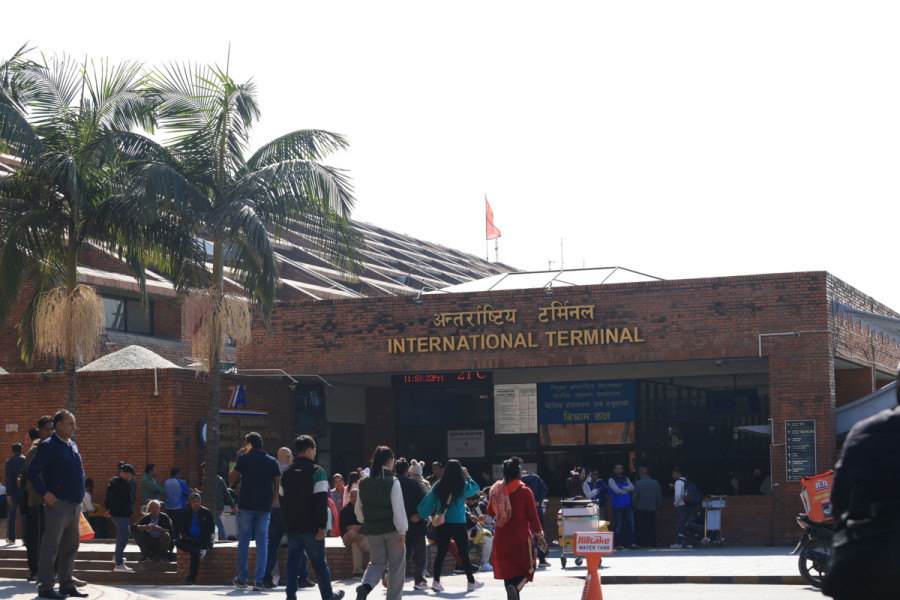Columns
Escaping the remittance trap
Nepal should wean itself off remittances and transition to healthier and more sustainable growth model.
Hridesh Gajurel
Excessive migration is arguably the most pressing issue facing policymakers in Nepal. Yet, little has been done to stem the incessant and voluminous flow of workers and students abroad or to encourage their return. This should not come as a surprise as Nepal has become over-reliant on remittances for economic stability and growth.
This article sheds light on how Nepal has inadvertently fallen into the trap of remittance-based consumption-led economic growth, a self-reinforcing process.
The article also shows that Nepal is not unique when it comes to falling into this remittance trap. The macroeconomic characteristics of other high-remittance countries are strikingly similar to Nepal, affirming the assertion that high remittances come with macroeconomic and structural straitjackets.
National growth models
From a demand-side perspective, national economies can be consumption-led, export-led, investment-led, or even government-spending-led. Moreover, the leading component of aggregate demand in a national economy will usually have a key underlying driver. For instance, many countries have consumption-led growth models but this consumption may be driven by high wages in one country (e.g., Denmark), by debt in another country (e.g., the United States), and by a real estate boom in a third country (e.g., Spain).
Political economists have thus far identified growth models that are export-led (e.g., Germany), debt-financed-consumption-led (e.g., the US and the United Kingdom), balanced (e.g., Sweden), construction-led (e.g., Spain and Australia), and foreign-direct-investment-led (e.g., Ireland and Hungary).
Looking at the aggregate demand components for Nepal for the last pre-Covid year of 2019, there appears to be a strong case for categorising Nepal’s growth model as being consumption-led.
Nepal’s final consumption expenditure was 85 percent of GDP, notably higher than India’s at 72 percent. This figure for China was lower at 56 percent. Even the US and the UK, considered consumption-led growth models, came in at 81 percent and 83 percent respectively.
Nepal’s exports amounted to a meagre 8 percent of GDP and government expenditure also made up just 8 percent of GDP, both at the lower end globally.
Gross fixed capital formation—the “investment” part of aggregate demand—totalled 34 percent of GDP in Nepal, one of the highest globally for the year. However, this figure also includes the construction of residential dwellings, which in many cases may just as well be considered a private consumption expenditure. The fact that foreign direct investment was less than 1 percent of GDP further undermines any notion that productive investment has been a key part of Nepal’s growth model.
Problem with import-heavy consumption
Nepal’s consumption-led growth model is heavily reliant on imports. Imports into the country amounted to 41 percent of GDP in 2019, at the higher end globally.
The problem with Nepal’s import-heavy consumption, of course, is its effect on the country’s balance of payments. A major imbalance between imports and exports usually spells trouble for a national economy, with the payments for imports rapidly depleting foreign currency needed for future imports that Nepal’s consumption-led growth model depends on. Nepal’s net exports (exports minus imports) stood at negative 34 percent of GDP in 2019, one of the worst globally.
The solution to this potentially disastrous problem for Nepal has been remittances from migrant workers. In other words, remittances have so far stabilised Nepal’s import-heavy consumption-led growth model.
Incoming personal remittances totalled 24 percent of Nepal’s GDP in 2019, the fourth highest in the world. This compares to an average of just 5 percent for the rest of South Asia and less than 1 percent for advanced economies.
The only other countries that had figures of 20 percent or higher for remittances were the small Pacific island nation of Tonga, the Central Asian countries of Tajikistan and Kyrgyz Republic, and the Central American nations of Honduras and El Salvador.
Similar macroeconomic problems
Intriguingly, all of these high-remittance countries had extremely high consumption levels as a share of GDP in 2019: 113 percent for Tonga, 87 percent for Tajikistan, 100 percent for the Kyrgyz Republic, 95 percent for Honduras, and 98 percent for El Salvador. Their imports were also among the highest in the world at 65 percent, 41 percent, 67 percent, 58 percent, and 46 percent respectively. The net exports of these high-remittance countries averaged negative 28 percent in 2019. This compares to a negative 3 percent for the UK and a negative 1 percent for the US.
In short, a high degree of reliance on remittances seems to go hand-in-hand with high imports and low exports.
This is not surprising as the high levels of migration that high remittances are based on shrink the pool of available workers and result in worker shortages and higher wages. This, in turn, undermines exports and internationally-exposed domestic industries, making imports more attractive. In the context of geopolitically-enforced policy constraints on trade, the country ends up importing a high proportion of its domestic consumption. The resulting lack of industrialisation and domestic production fans unemployment, forcing people to go abroad for employment opportunities. This is the vicious cycle of labour migration.
Based on this analysis, it appears that countries like Nepal with high levels of migration and remittances are resigned to a growth model that hamstrings the industrial sector, especially internationally-exposed sectors, slowing down economic development.
Nevertheless, given how harmful the remittance-based growth model is for Nepal’s long-term economic prospects, Nepal needs to wean off of remittances and transition towards a healthier and more sustainable growth model as the remittance-reliant growth model is counterproductive in the long run.
Escaping the remittance trap
The Nepali government cannot stop migration by impinging on the long-standing right of freedom of movement. But there are more practicable and easier actions it could take that might slowly and safely reduce net migration and the dependence on remittances over time. These actions would be in addition to improving educational institutions and creating employment opportunities, which are obvious prerequisites for a reversal of net migration.
First, the government could encourage the Nepali diaspora’s highly patriotic or disenchanted portions to return to Nepal. Encouraging return would be effective in getting at least some people to return. The recent offer of a dual citizenship to non-resident Nepalis (NRNs) is a good first step but more active encouragement to return would help further.
Second, the government could also do more to help returnees with skills acquired abroad to actively engage in the economy and in government, including through government-created work opportunities, so that they become less likely to go abroad again.
Additionally, given the perilous and miserable conditions of so many Nepali migrant workers abroad, the federal government, together with provincial and local governments, could engage in a vigorous awareness and information campaign across Nepal to discourage labour migration, especially to regions with highly exploitative practices.
Such multi-pronged efforts might help slowly reduce net migration, which is exactly what is needed to transition to a healthier and more sustainable growth model based on productive investment, skilled work, tourism (including internal tourism) and green growth.




 12.99°C Kathmandu
12.99°C Kathmandu













%20(1).jpg&w=300&height=200)

